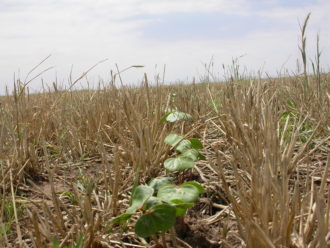The Cover Crop Economic Decision Support Tool is a spreadsheet-based partial budgeting tool. A partial budget only captures the costs and benefits that are expected due to a change in the operation. The tool is available for download from the following locations: NRCS Missouri Soil Health Website (https://www.nrcs.usda.gov/wps/portal/nrcs/mo/soils/health/); or NRCS Illinois Soil Health Website (https://www.nrcs.usda.gov/wps/portal/nrcs/il/soils/health/).
An instruction page is provided within the tool. Please review the instructions to understand the inputs required by the user and the results the tool provides. The analysis depends upon user supplied values. Where a user is unsure of the exact variables, the tool can be used to run “what if” scenarios based on different potential ranges of inputs. The model will store and retrieve up to 5 default scenarios to provide a starting point for running the model. Users can also create and save their own default scenarios. Analysis results are provided both numerically and graphically. A references and citations page is included in the tool providing users with additional technical and scientific detail utilized to build the tool.
Cost and Benefit Variables
The following cost variables are included in the model: 1.) cover crop establishment and management; 2.) yield decrease in cash crop following cover crop; and 3.) other operation specific costs such as additional fertilizer applied to cover crop to maximize biomass production. Both short term and long term benefits are captured in the tool. Short term benefits include: 1.) direct nutrient credit; 2.) herbicide, pesticide, fungicide input reduction; 3.) yield increase in cash crop following cover crop; 4.) reduced erosion; 5.) grazing, baling, and seed production; and 6.) other operation specific short term benefits. Erosion reduction includes on-site soil fertility loss, off-site water quality impacts, and erosion repair costs. Long term benefits include: 1.) overall soil fertility improvement and 2.) water storage benefits (increased infiltration).
Results
Results are presented showing short term and long term net benefits (up to 50 years). The long term benefits assess the impact of improved soil health with continued use of cover crops. Short term net benefits ($/ac) are total benefits ($/ac) minus total costs ($/ac) associated with adopting a cover crop. Long term benefits consider the analysis lifespan (years), discount rate (%), current soil organic matter (%), estimate of years of management change needed to increase soil organic matter by 1% (years), and an estimate of maximum potential soil organic matter (%).
Economic and financial analysis results are presented in the tool:
- An economic analysis compares the amortized costs and benefits and answers the question: Is this management change profitable over the lifespan of the analysis? If net benefits are positive then the investment is economically viable.
- A financial analysis answers the question: Is this management change affordable? Depending on the variables in the model, on a year to year basis there may be a negative net benefit, especially in the first few years of utilizing cover crops in the rotation until the longer term soil benefits are realized. The producer can use this analysis to determine if he/she can afford to invest in cover crops, or use the model to assess alternatives to make the investment more affordable for the operation.
Alternatives
In the model, producers have three different alternatives they can include in the analysis: grazing, baling, and seed production. For grazing, there are two options—stockers or cow/calf operations. The stocker option captures the grazing value of cover crops based on Average Daily Gain. The cow/calf option captures the grazing value of cover crops based on forage value. For baling, producers would enter the expected yield, forage value, and baling costs to calculate the total baled forage benefit. For seed production, producers enter seed harvest cost, seed yield, and seed value to calculate total seed production benefits. These alternatives are included in calculating both short term and long term benefits.
Additional Information
On the NRCS Missouri Soil Health website, interested parties can access:
- The Cover Crop Economic Decision Support Tool;
- Video demonstrations of the tool and information flyer;
- A cover crop questionnaire designed to capture the information needed from producers to populate the tool; and
- Cover crop economics case studies based on experiences of Missouri producers utilizing cover crops.
This product was developed with support from the Southern Sustainable Agriculture Research and Education (Southern SARE) program, which is funded by the U.S. Department of Agriculture—National Institute of Food and Agriculture (USDA-NIFA). Any opinions, findings, conclusions or recommendations expressed within do not necessarily reflect the view of the Southern SARE program or the U.S. Department of Agriculture. USDA is an equal opportunity provider and employer.
